Fuelling the perfect marathon performance means considering your pre-event nutrition as well as taking the correct fuel sources on board at the right times during the marathon itself. We guide you through these areas, whilst also advising you on how to optimise your recovery once your mission is complete.
Introduction
Having already covered Fuelling Your Marathon Training in our previous article, here we consider the final part of the nutritional puzzle – fuelling your actual marathon.
In this article, we consider the nutritional timeline starting with carbohydrate-loading as you approach the big day, the perfect pre-race breakfast in the hours before your marathon, fuelling during the event and your post marathon recovery strategy. You don’t need any surprises on the day, so planning is crucial. Following the steps discussed here will support you to achieve the result you have been training so hard for.
It’s important to highlight from the outset that the horror stories you may hear and read like ‘hitting the wall’ (due to running out of stored carbohydrate), dehydration and stomach issues are all entirely avoidable. We will provide you with the educational tool kit to ensure that these issues do not become reality.
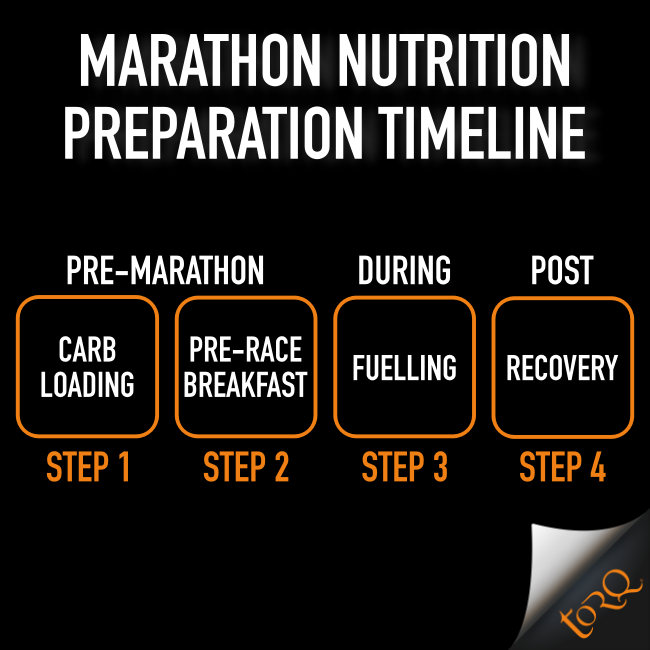
The attention you pay to your nutrition in the days leading up to your marathon will provide the proper nutritional foundations upon which a fuelling strategy can be built during the marathon. To use the analogy of a car, before a long drive, we would fill the fuel tank up to full capacity, and thus, the longer our range would be. The same consideration should be made to our physiological fuel tanks – the muscles and the liver.
Step 1: Carbohydrate Loading
For the finer detail on carbohydrate loading, please refer to our Carbohydrate Loading Update article. The aim of carbohydrate loading is to fully saturate the muscles and liver with fuel ahead of a long run and a marathon is a long run! Not only will carbohydrate loading ensure that your stores are full, a successful carbohydrate loading protocol will actually stimulate higher than normal levels of carbohydrate storage.
Glycogen is the name given to the form of carbohydrate stored in skeletal muscle and the liver and it’s the preferred fuel source used by the body during periods of moderate to high intensity endurance exercise, the sort of intensity in which you would aim to run a marathon. Importantly, the higher the exercise intensity becomes, the more glycogen we burn per minute, with some studies suggesting it is possible to burn up to 3g/min. That’s equivalent to 180g per hour!
Whilst you may be thinking that 180g doesn’t sound like a lot, it becomes a lot more important when you consider the limited amount we can store. Humans have a very limited capacity to store glycogen, amounting to as little as 500g at full saturation. Therefore, at a burn rate of 180g per hour, it’s easy to see how we can deplete our glycogen stores to critically low levels in as little as 2.5 hours. This also assumes that you started your marathon with fully saturated glycogen stores in the first place and that you have paced yourself properly. A faster pace will burn your stored glycogen more quickly and if you have less in the fuel tank to begin with, your stores will empty more quickly.

If you have read our Fuelling Your Marathon Training article, you will likely have started to implement a carbohydrate loading strategy into your longer runs and will hopefully be accustomed to the benefits it offers with regards to extending you time to exhaustion.
In the early 2000’s studies aimed to overcome the practical limitations from the early carbohydrate loading protocols, which were long and drawn out over several days. Researchers found that one of the most effective strategies of carbohydrate loading (a strategy still promoted by the sport science staff at TORQ) didn’t need to be activated until the day before the marathon. All you need to do is complete a progressive 5 minute warm up followed by a 3-minute exhaustive interval, which could be completed indoors on a treadmill or outdoors, followed by a cool down and the consumption of a very high carbohydrate Recovery Drink. The only caveat we would like to give here is that if you’re going to be running hard for 3 minutes the day before your marathon, you should have been doing some interval training (high intensity work) as part of your marathon preparation. If you haven’t, don’t go too hard during this 3 minutes – you don’t want to be aching on marathon morning!
After the recovery drink, you will need to keep eating carbohydrate. Research suggests consuming upwards of 12g of carbohydrate per kg bodyweight for the next 24 hours, which equates to 840g of carbohydrate for a 70kg person. For most of you, figuring out what 840g of carbohydrate looks like can be difficult, but the best advice we can give is it’s a LOT. You’re better having too much than not enough, so do your best to plan what you’re going to eat over that last 24 hours so that you know that it is enough. Considering the nutritional data on food packaging can really help with this. We give some advice on how to achieve this next, but as previously mentioned, we cover this subject in significant detail in our Carbohydrate Loading Update article.
Don’t just eat more: As we start our carbohydrate loading phase, it’s important that we stick to the goal: eating more ‘carbohydrate’. Therefore, the overall portion size of the plate may not vary much beyond what you would typically consume during a high load training week, but it’s the percentage of the food groups that should be altered. For most of us participating in endurance sport, we would consume what is known as a mixed diet consisting of around 50-55% carbohydrate, 20-25% protein, and 20-30% fat per day. During a carbohydrate loading phase, we would aim to achieve 70-80% of carbohydrate whilst maintaining 15-20% protein. You can see that this doesn’t leave much of a percentage for fat – so minimal fat intake is key for a successful carbohydrate loading campaign.
Hydration is key: Staying hydrated is another key determinant of a successful carbohydrate loading strategy, so drink plenty of water. Water availability is essential for effective carbohydrate loading and research has demonstrated that the ratio between water and glycogen is 3:1, so for every gram of carbohydrate stored, 3 grams of water is required. Knowing that we can store 500g worth of functional fuel in the form of carbohydrate and that a further 1.5Kg of water will be stored with this, it should come as no surprise that you’re a bit heavier than usual on race day morning. If you are, give yourself a pat on the back, safe in the knowledge that your carbohydrate loading regime has been a success. Don’t worry about the extra weight though – as you start to run, you will burn carbohydrate and release water, which will be expired through perspiration, so you will get lighter as the marathon progresses, just as a car gets lighter as it empties its fuel tanks on a long journey.

Consider your carbs: It’s likely that those of us training for a marathon will have a good understanding of foods that are considered healthy and less healthy and that’s a great position to be in. When it comes to carbohydrate loading however, it may be one time that we purposely blur the lines between those two camps. As we discussed earlier, we need to aim to consume around 12g of carbohydrate per kg of bodyweight after our exhaustive 3-minute interval to fully replenish stored glycogen. Whilst your typical healthy carbohydrate choices such as rice, pasta and potatoes will offer carbohydrates, the additional nutrients within them (fat, fibre and protein) will also make you feel full for some time after the meal. Whilst these meals should still feature within your strategy, you will find it very difficult to achieve such high values (12g/kg) if all of your calories are to come from these foods. You should therefore look towards including simple carbohydrates. For instance, sweets like jelly babies, wine gums, popcorn and flavoured rice cakes (sweet or savoury) will make hitting your carbohydrate intake goals much easier. Did you know that if you put honey onto a piece of toast, you double its carbohydrate content?
TORQ Fuelling System products such as a TORQ Bar or Explore Flapjack are also really handy high carbohydrate/low fat snacks and remember that TORQ Energy Drink contains both carbohydrate and water and is quite easy to consume when you’re fed up with eating calories! Our SNAQ 5:1 Carbo-Load Breakfast, mentioned a little further on also delivers a massive 125g of carbohydrate, so would be the perfect last meal of the day.
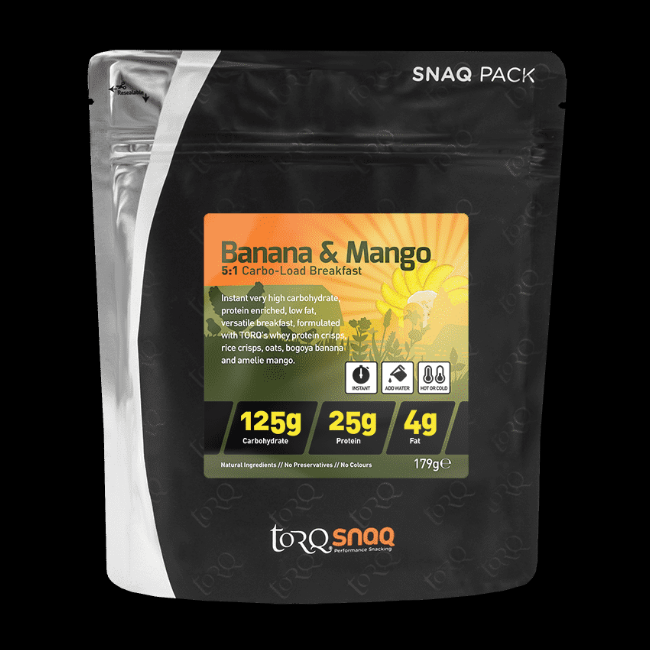
Also, seriously consider our Carbohydrate Loading specialist product, TORQ Organic Energy Powder, which is flavourless and can be added to our flavoured Energy Drinks at high levels to boost their carbohydrate content. This powder can also be added into pasta sauces, soups or pancakes to increase the carbohydrate content or even to cups of tea and coffee! Whilst boosting the carbohydrate content of foods, this supplement is almost undetectable due to its neutral flavour.
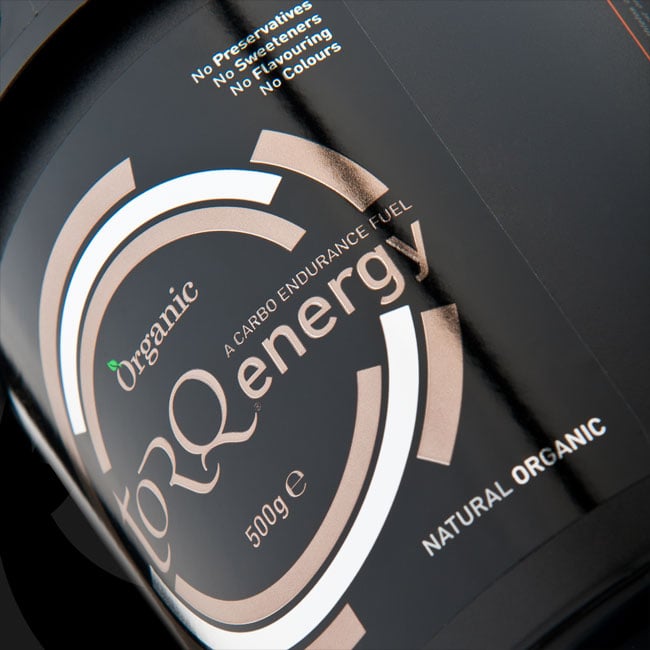
Step 2: Your Pre-Marathon Breakfast
Your pre-marathon breakfast is your last opportunity to consume any significant fuel before you arrive on the start line. The goal of the pre-marathon breakfast is to top up your liver glycogen after your overnight fast. Once carbohydrate enters the muscle cells it cannot leave and will not disappear until it is used as a fuel when you’re running. Liver glycogen on the other hand will be used overnight for general metabolic processes (keeping you alive). Much in the same way your thermostat in your house regulates temperature, the liver is known as a “glucostat” and constantly regulates the amount of glucose circulating in the blood to keep it within the very tightly controlled optimal range. During the night when we sleep, our major organs still require fuel to function and it’s glucose from liver glycogen that provides this fuel. Upon waking, your liver glycogen is likely to be significantly depleted, leaving a dent in your available fuel stores for the marathon.
You should aim to consume your pre-marathon breakfast around 3–4 hours before you arrive on the start line. This sounds like a long time before the gun fires, but the last thing you want to be doing is digesting this food whilst running. The composition of your breakfast should contain 1–2g of carbohydrate per Kg of bodyweight, which works out as 70-140g of carbohydrate for a 70Kg person. As your marathon is still multiple hours away, it’s really important that you also consume an easily digestible 20-25g source of protein with your breakfast, because this will be your last ‘meal’ before you finish your marathon and as discussed in our Fuelling Your Marathon Training article and in greater detail in our Protein & Performance article, regular protein intake is essential in protecting your hard-earned fitness gains.
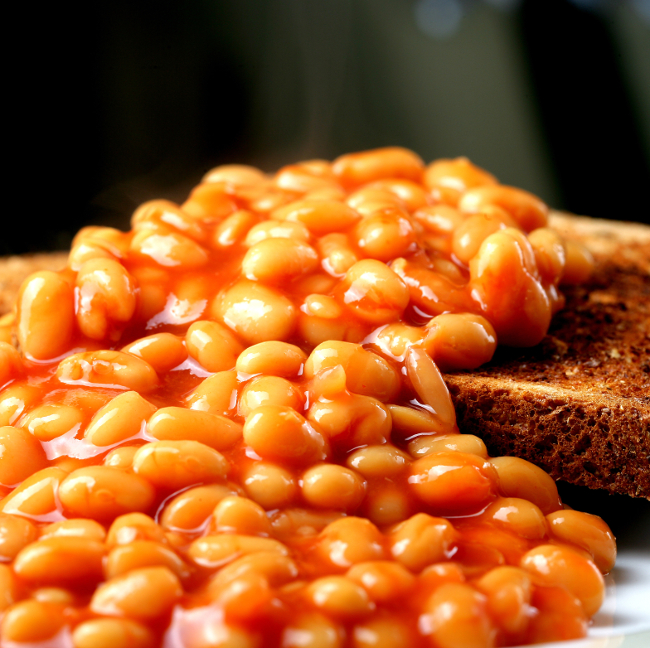
An example of a hearty low fat, high carbohydrate breakfast that would deliver around 80g of carbohydrate would be good old ‘beans on toast’ (assuming two pieces of toast and a whole can of beans). You can increase the carbohydrate content easily too by adding a scoop or two of TORQ Organic Energy Powder to your beans. You won’t even notice it’s in there. Protein wise, you’ll hit your 20g target too, but you could also add a single poached egg to make absolutely sure.
To help you remove the stress of sourcing, making, preparing or planning your perfect pre-race breakfast, TORQ has produced both a 3:1 Pre/Post Exercise Breakfast and a 5:1 Carbo-Load Breakfast within our SNAQ range. These breakfasts pack a punch by delivering 75g and 125g of carbohydrate respectively, with both of them providing the golden target of 25g of protein. This offers a solution for people of all body weights – simply choose the ratio that fits your 1-2g/kg target.
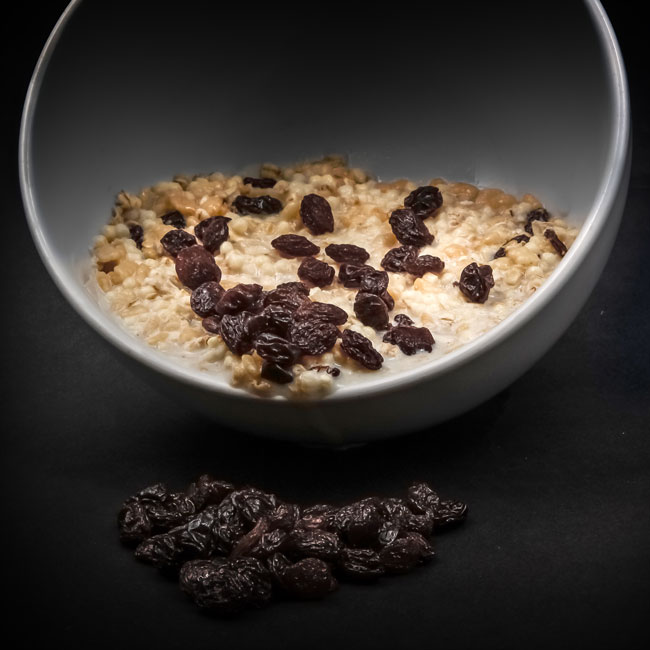
Pre-Marathon Hydration
When it comes to endurance running races such as a marathon, hydration in the hours approaching the start is critical due to the practical challenges of not being able to carry large volumes of fluid whilst running (compared with sports like cycling where bottles can be carried on the bike). Therefore, to get the best possible start, you need to ensure that you’re fully hydrated before you begin.
Hydration is responsible for a whole number of factors that will our influence performance, such as thermoregulation, cardiovascular capacity, cognitive performance and intestinal absorption. We discuss these in detail in our Hydration: The Definitive Guide article.
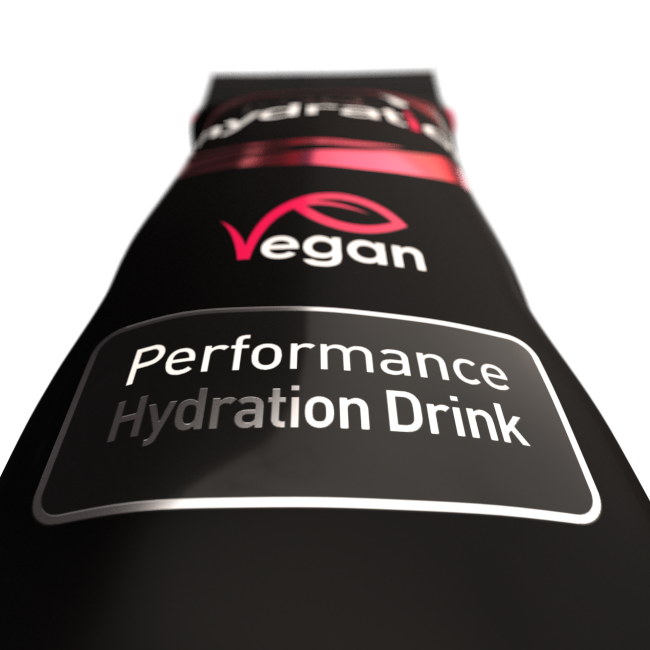
According to the American College of Sports Medicine (ACSM), to ensure that you are hydrated on the start line, you will need to do some basic testing by checking the colour of your urine. Simple yet effective. You should be aiming for urine which is light in colour or even clear. You should check this 4 hours before you arrive on the start line (so around the same time you consume your pre-marathon breakfast) and you should regularly sip 500ml of a hypotonic electrolyte/carbohydrate solution such as TORQ Hydration Drink over the next 2 hours. If you find after the first 2 hours that your urine colour is still dark (showing signs of dehydration) then you should consume another 500ml over the 2 hours before the marathon begins. Following these steps will ensure that you arrive at the start line in a hydrated state.
Step 3: Fuelling The Marathon
The time has come. You are standing on the start line hydrated, fully glycogen loaded and primed for your best performance. From here on in, we guide you through the steps on how to fuel your marathon correctly ensuring you don’t hit the dreaded wall and that you feel as strong in the last mile as you did in the first.
As previously outlined, once you have completed your carbohydrate loading regime, you will have stored about 500g of carbohydrate, which will keep you going for some time, but once this stored carbohydrate is used up, you will hit the wall and will be running nowhere! Zero Carbohydrate = Zero Performance. Hitting the wall is a particularly unpleasant experience and it doesn’t matter how fit you are, without fuel, your engine can’t function. To use a car analogy again, you could have the fastest car in the world sitting in front of you, but if the fuel tank is empty it will go slower than a 2nd hand hatchback running on one cylinder!
The way to avoid ‘hitting of the wall’ is to fuel consistently and regularly with carbohydrate products like those found within the TORQ Fuelling System range. We need to emphasise ‘consistently and regularly’ because so many people view an Energy Gel as an emergency tool to get them out of a tricky situation – in other words, they think they should take it if they ‘hit the wall’ to help get them to the finish line. This is definitely not how to fuel a marathon and you will need to follow a much more proactive approach – one that doesn’t leave you limping across the finish line in a sub-optimal time.
The human body will burn carbohydrate at a rate far greater than we can absorb it from the energy products we consume, so from the moment you start running, your carbohydrate stores will start to deplete. The difference is that if you start fuelling from the beginning of your marathon, every gram of carbohydrate you consume will be burnt preferentially over your stored carbohydrate. In other words, the fuel you take on board from energy products slows down the depletion of your carbo-loaded stores.
The video below is about 5 minutes long and if there’s one thing you do today (despite reading this far) to help you get your best possible marathon performance, it’s to watch it. We make understanding why you should be fuelling your marathon absolutely crystal clear:

To ensure that you don’t hit the wall, you should start fuelling immediately, taking your first energy gel on the start line as you set off. This will make exogenous carbohydrate (fuel from energy products) available, immediately protecting your stores, helping you to extend your time to exhaustion and affording you a higher pace.
Your exercise intensity will determine how much carbohydrate you need to ingest per hour. Of course, the harder and faster you run, the more carbohydrate you will burn and the sooner you will deplete your fuel tanks. Our recommendation based upon the scientific literature is to target 60g/hr for lighter intensities and 90g/hr of carbohydrate for higher intensities. The beauty of the TORQ Fuelling System is that it makes fuelling with the correct amount of carbohydrate very easy. Each of TORQ’s fuelling products contains 30g of carbohydrate and each one of these we call a TORQ Unit. 60–90g of carbohydrate simply equates to 2-3 TORQ Units per hour.
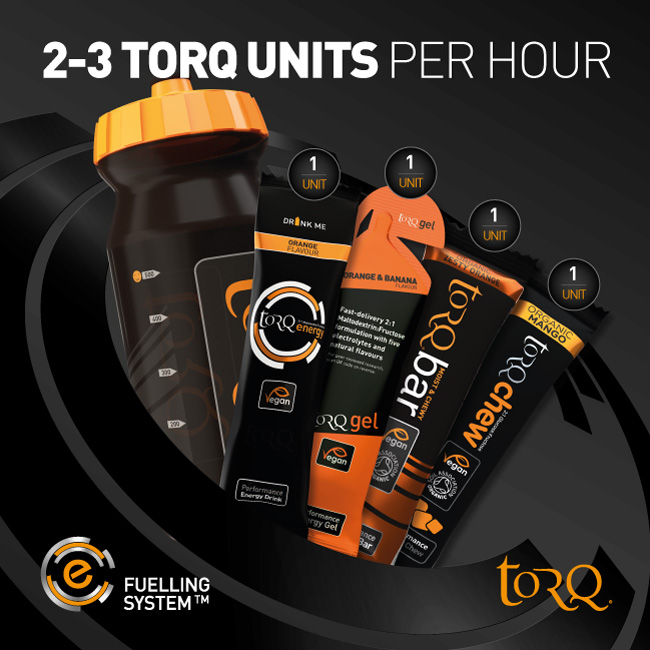
Although all of the products pictured above all represent a TORQ Unit, the TORQ Gel proves to be by far the most popular fuel choice for marathon runners and we would strongly recommend it. If your preference is to consume a Bar or Chew, it’s not a problem, but most runners find the gels the most convenient choice.
When considering whether to take on board 60 or 90 grams of carbohydrate per hour (2 or 3 TORQ Units), have a think about what you’re wanting to achieve from your marathon? It may be that your lifelong ambition has been to complete a marathon and simply get across that finish line, in which case 2 TORQ Units per hour would be perfect. On the other hand, you might be driven to get as fast a time as possible and will want to pull out all the stops. Always remember that the combination of carbohydrate loading and fuelling with 3 TORQ Units per hour affords you a higher pace, so fuelling at these levels means that you really can be bold and go for it!
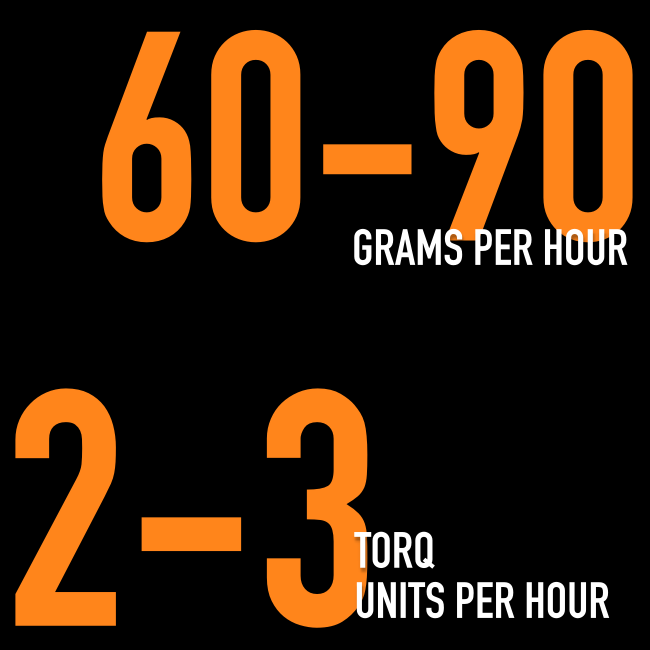
Whilst you can plan your fuelling in advance, the one thing you can’t plan so precisely for is your hydration strategy. Your hydration requirements are directly related to your perspiration rate and this is influenced by the environmental temperature, the clothing you wear and the intensity of exercise. The more you sweat, the more fluid and electrolytes you will need to consume to replace those lost.
One of the benefits of running an organised marathon is that they will have regular feed stations where you can pick up water on the go. Bearing in mind that TORQ Gels contain 5 electrolytes anyway, using plain water to wash down a gel at these feed points is a perfectly sound protocol under most environmental conditions. There are times however where the environment throws up a bit of a heatwave on marathon day and this is where you might need to think out of the box somewhat.
TORQ Hydration Drink contains high levels of the 5 key electrolytes (sodium, potassium, magnesium, chloride and calcium) and is available in very small easy to carry sachets. For the sake of a few extra seconds spent at a feed station at a couple of points during the marathon, it would be well worth the time to tip one of these sachets into 500ml of water. Combining TORQ Hydration Drink with water-only in this way would be a good strategy during hotter environmental conditions. One thing to bear in mind with this warm weather strategy is that if you’re ‘going for it’ and aiming to fuel with 3 TORQ Units per hour, TORQ Hydration Drink represents 0.5 TORQ Units, so for the hour that you are consuming it, knock your gel intake back slightly. If you’re aiming for 2 TORQ Units per hour from the outset, you can continue as normal, this advice is only for those of you pushing for the upper absorption threshold of 3 TORQ Units per hour.
Another important point to note, as explained in our Hydration Guide is that a good state of hydration is critical to the absorption of your fuel (gels), so if you do find yourself getting stomach discomfort, this can be easily turned around by stopping fuelling and focussing on hydration alone for a short while. As soon as the discomfort eases, it’s vital then that you get back onto your fuelling. The key message here is that you can’t fuel properly in a dehydrated state.
The short video below demonstrates how to fuel and hydrate during a marathon, so please take the time to watch it. Please note that the video makes reference to a product called ‘TORQ Hypotonic’ which is the old name for TORQ Hydration Drink.

Hydration is a hugely important topic and we encourage you to take the time to read our definitive Hydration Guide where we leave no stone unturned on the subject. The key messages in this Hydration Guide are that you should aim to drink slightly ahead of thirst, not wait until you feel thirsty and, as mentioned above, that becoming dehydrated will influence your ability to take on board and use fuel. If you want to hit your 60-90g of carbohydrate per hour fuelling target, you will need to make sure you remain hydrated.
The other article well worth reading is our Training Your Digestive System article, because although the research supports ingestion rates of 60-90 grams of carbohydrate per hour, you should always give yourself the best chance of success and practice fuelling during training. There are also certain things you MUST avoid on marathon day, which could have a negative impact on your ability to fuel and hydrate optimally.
Late-Stage Caffeine Ingestion
Caffeine is commonly used by runners to alleviate the sensations of fatigue during the final stages of a marathon, but it’s important to note that the response to caffeine is highly individual and so we recommend that you practice late-stage caffeine ingestion during your training to ensure you respond well to the added stimulus.
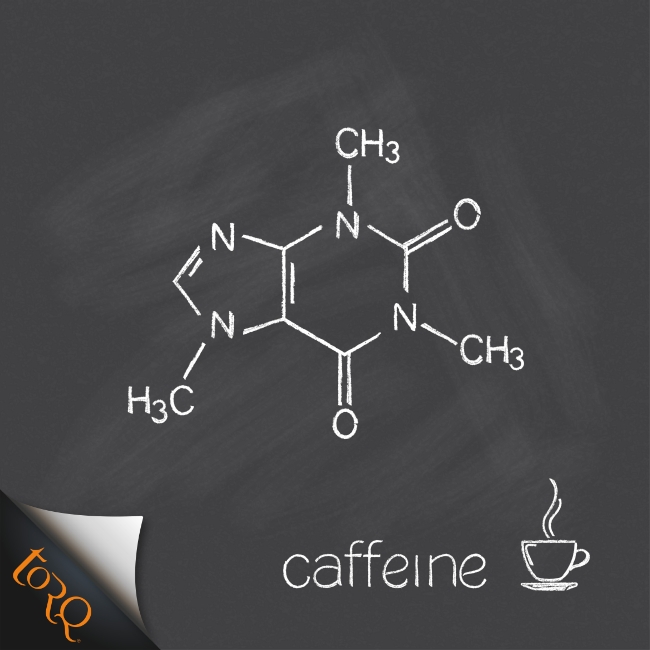
As the marathon draws into its latter stages, fatigue can start to set in and quite frankly it will have been quite a while since you’ll have had your last cup of tea or coffee. This will result in an increased rating of perceived exertion, loss of focus and a decline in mood state. This can spiral into an increasingly negative experience with a consequential drop in performance.
Caffeine has been proven to reduce the rating of perceived exertion and help to blunt this negative psychology. Combined with increases in muscular efficiency driven by caffeine consumption and an increased state of mental alertness, focus and mood elevation, these negative feelings can be quickly turned around after a well-timed shot of caffeine.
Caffeine absorption takes around 40 minutes to become fully present in the blood after ingestion and so this should be a key consideration when choosing to take it. For example, if you are planning to run a 4-hour marathon and you know from your training that your rating of perceived exertion starts to increase at hour 3, you may wish to consume caffeine at around 2.5 hours to account for the lag time. You will feel the benefits sooner than 40 minutes after intake, but caffeine will peak in your blood some time later. Interestingly caffeine has a half-life of around 4-6 hours, so once you’ve taken it, you shouldn’t need another one. Some people do choose to take caffeine gels earlier on in their marathon and more regularly throughout, which is fine and there’s a strong argument to say that this could offer performance advantages, but you’re unlikely to feel the step-change kick that caffeine can give at that vital point in the event. Practice in training and see what works for you. If you’re a regular caffeine consumer, you will be desensitised to it and may well benefit from more caffeinated gels.
Caffeine can be found in 4 of TORQ’s Energy Gels (89mg/gel) delivered by natural guarana. This is a significant and highly noticeable dose of caffeine. To learn more about caffeine, its effects on exercise performance and how to accurately determine your caffeine dosing quantities, we highly recommend exploring the information found in our How Can Caffeine Boost Performance article.
Step 4: Post Marathon Recovery
Once you have completed your marathon, the final part of the nutritional puzzle to consider is your post exercise recovery. Understandably, this may not be the first thing on your mind as you cross the finish line, but hopefully if you’ve followed our previous article Fuelling Your Marathon Training you will be well versed in taking on board a Recovery Drink immediately after completing a training session. The marathon is no different and the sooner you get those nutrients into your body, the better. Providing the body with carbohydrate, protein, vitamins and minerals (ingredients found within TORQ Recovery Drink) within 15 minutes of finishing your marathon will help to begin the repair process and support your suppressed immune system – feeling tired is one thing, but you certainly don’t want to get ill.
It’s fair to say that the recovery from such a big event will take days, possibly weeks as a marathon imposes significant stress upon the body. Your appetite is likely to be elevated anyway for a few days, so just listen to your body and eat plenty of fresh fruit and vegetables and ensure that you’re getting regular intakes of 20-25g of protein as this will significantly hasten the repair process. We cover the importance of protein in detail in our article Protein, Performance & 20-25g Protein Recipes.
When all is said and done however, aside from the Recovery Drink immediately after your marathon, of course, we are all human, and so every significant achievement must be accompanied by a celebration! This certainly isn’t a time to feel guilty about cracking open a bottle of wine or beer (or 2) to celebrate the success of a significant sporting challenge!

Practical Tips For Carrying Your Nutrition
When it comes to looking at ways to carry your nutrition, we thought that we would get some expert advice from a #TORQFuelled GB representing & British Ultra Trail Champion (2021), Meryl Cooper. Meryl is currently a high performing athlete and run coach, who has worked with TORQ over a number of years to optimise her own nutritional strategies and of course had to overcome all of the challenges you are likely to face as you prepare for your marathon.

Here is what Meryl had to say:
“When I am working with runners preparing for long endurance events such as a road marathon we make sure that the weekly long run is used as an opportunity to practice all aspects of race fuelling, including how to overcome the practical challenges of carrying your nutrition. This means that by race day you have built up great habits and become entirely familiar with how you are going to fulfil your nutritional requirements practically and logistically. Practising fuelling regularly on your long runs will allow you to work out the best way for you to carry your fuel. From experience, the equipment most typically used by runners to carry their fuel is zip pockets, a waist band, a lightweight pack/run vest, or even handheld bottles.
It’s also important to familiarise yourself with the event rules and regulations as some races allow you to get support on the course allowing runners I work with to grab a handheld bottle or gel at certain points on the course.
Whatever you do, make sure you have practiced it in training exactly as planned and at race intensity. If something is irritating you in a 16-mile training run (e.g. gels swinging around in your pockets, or the waistband feeling a bit tight) then make sure you try something else as it will most certainly irritate you on the day of the marathon! Making good habits in training and solving problems as you go are key to success and enjoyment on race day! This learning process takes time also, so start it as early as you can.”
You can learn more about Meryl here.
Conclusion
Preparing your nutritional strategy for a marathon doesn’t need to be complicated if you break it down into the 4 steps of Carbohydrate Loading, Pre-Event Breakfast, Fuelling During Marathon and Recovery After Marathon. If planned correctly, this should be something you look forward to rather than dread. Paying attention to your carbohydrate loading and hydration pre-event will ensure that your muscle glycogen and water availability is maximised as you hit the start line. Your fuelling and hydration during the event ensures that you maintain your fuel availability, allowing you to extend your time to exhaustion and afford a higher pace. Finally, your post exercise Recovery Drink will kickstart the recovery process and support your immune system. Ensuring regular protein intake over the days following the marathon along with plenty of fresh fruit and vegetables will further hasten the recovery process.
Wishing you the best of luck with your marathon performance!
Trying TORQ?
If you’re interested in purchasing TORQ products, we strongly advise training with them first, so that you can be 100% confident with your marathon day strategy. The easiest way to sample our products is to choose individual items from our ‘Build a Sample Pack’ page on this website:
Alternatively, TORQ products are widely available from the following stores:
Sainsburys (selected stores)
If you have any questions about this article or any other subject, please don’t hesitate in contacting us at enquiries@torqfitness.co.uk or phone 0344 332 0852.






